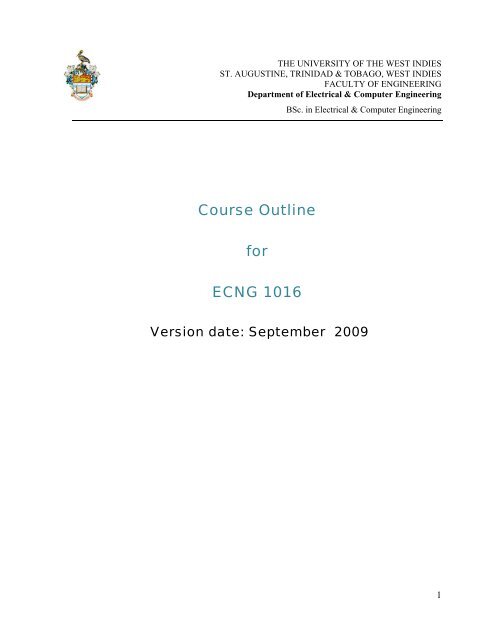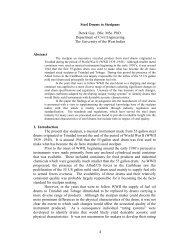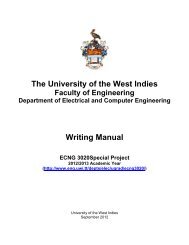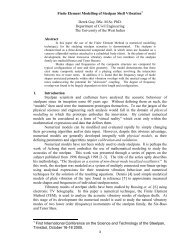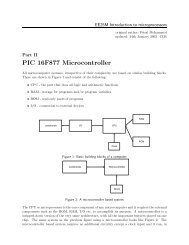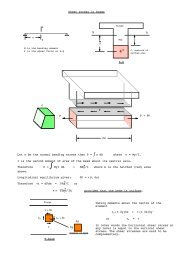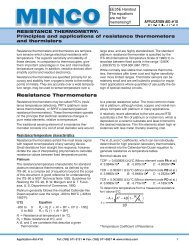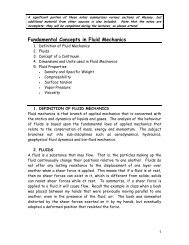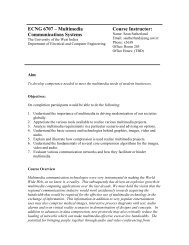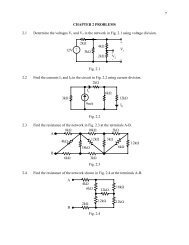Course Outline for ECNG 1016 - Faculty of Engineering - The ...
Course Outline for ECNG 1016 - Faculty of Engineering - The ...
Course Outline for ECNG 1016 - Faculty of Engineering - The ...
You also want an ePaper? Increase the reach of your titles
YUMPU automatically turns print PDFs into web optimized ePapers that Google loves.
THE UNIVERSITY OF THE WEST INDIESST. AUGUSTINE, TRINIDAD & TOBAGO, WEST INDIESFACULTY OF ENGINEERINGDepartment <strong>of</strong> Electrical & Computer <strong>Engineering</strong>BSc. in Electrical & Computer <strong>Engineering</strong><strong>Course</strong> <strong>Outline</strong><strong>for</strong><strong>ECNG</strong> <strong>1016</strong>Version date: September 20091
Contents1 General In<strong>for</strong>mation........................................................................................................32 <strong>Course</strong> Overview ............................................................................................................42.1 <strong>Course</strong> Description..................................................................................................42.2 <strong>Course</strong> Rationale.....................................................................................................42.3 <strong>Course</strong> Aims............................................................................................................42.4 <strong>Course</strong> Learning Outcomes.....................................................................................42.5 <strong>Course</strong>-to-Programme Learning Outcomes Checklist........ Error! Bookmark notdefined.3 <strong>Course</strong> Assessment .........................................................................................................63.1 Breakdown <strong>of</strong> Assessment Artefacts ......................................................................63.2 Linkage <strong>of</strong> Assessment Artefacts to <strong>Course</strong> Learning Outcomes ..........................64 <strong>Course</strong> Delivery ..............................................................................................................74.1 Schedule and Venue................................................................................................74.2 Target Delivery Schedule .......................................................................................75 Resources ........................................................................................................................95.1 Required Readings..................................................................................................95.2 Recommended Readings.........................................................................................95.3 Other Resources......................................................................................................95.4 <strong>Faculty</strong> / Campus Facilities Required <strong>for</strong> <strong>Course</strong> Delivery Error! Bookmark notdefined.5.5 Departmental Resources Required <strong>for</strong> <strong>Course</strong> Delivery .... Error! Bookmark notdefined.6 Student Conduct ...........................................................................................................106.1 Student Attendance ...............................................................................................106.2 Extended Absence from Class ..............................................................................106.3 Missed <strong>Course</strong>work Exams Policy .......................................................................106.4 <strong>Course</strong>work Late Submission Policy....................................................................106.5 Policy on Re-Use <strong>of</strong> Previous <strong>Course</strong>work Grade................................................116.6 Statement <strong>of</strong> Academic Honesty...........................................................................112
THE UNIVERSITY OF THE WEST INDIESST. AUGUSTINE, TRINIDAD AND TOBAGO, WEST INDIESFACULTY OF ENGINEERINGDepartment <strong>of</strong> Electrical and Computer <strong>Engineering</strong>BSc. Electrical and Computer <strong>Engineering</strong><strong>ECNG</strong> <strong>1016</strong>MATHEMATICS FOR ELECTRICAL ENGINEERS Ihttp://myelearning.sta.uwi.edu/1 GENERAL INFORMATION<strong>Course</strong> level: Level 1 Semester(s) <strong>of</strong>fered: II<strong>Course</strong> status: Core Elective OccasionalDelivery mode: Lecture Online TutorialCredits: 1 Estimated totalstudy hours 1 :Estimated 100enrollment:15+30<strong>Course</strong>Dependencies 2Recommendedprior knowledgeand skills 3 :Pre-Requisites None<strong>The</strong> prospective student <strong>of</strong> <strong>ECNG</strong> <strong>1016</strong> should• have knowledge <strong>of</strong> the techniques <strong>of</strong> calculus <strong>of</strong> a singlevariable as defined by the syllabus <strong>of</strong> CAPE Pure MathematicsUnits I and II• be able to apply the fundamental methods <strong>of</strong> calculus <strong>of</strong> severalvariables taught in MATH 1180• have the ability to solve constant coefficient non-homogeneouslinear ordinary differential equations <strong>of</strong> arbitrary order<strong>Course</strong> Staff Position/Role E-mailPhoneMr Fasil Muddeen Lecturer fmuddeen@sta.uwi.edu 662-2002DemonstratorOffice3151OfficeHours1 Estimate includes teaching time, study time, and student preparation time <strong>for</strong> classes and labs.2 Include any Co-requisites, Post-requisites, or Forbidden course combinations with respective code (C/P/F).3 Lecturers can state course input requirements in terms <strong>of</strong> student behaviours (See Bloom’s Taxonomy –Appendix).3
2 COURSE OVERVIEW2.1 <strong>Course</strong> Description<strong>ECNG</strong> <strong>1016</strong> introduces students to the theory and application <strong>of</strong> the Laplace Trans<strong>for</strong>m. <strong>The</strong>Laplace trans<strong>for</strong>m is an essential mathematical tool <strong>of</strong> an electrical engineer used <strong>for</strong>analyzing certain systems <strong>of</strong> differential equations which, because <strong>of</strong> the nature <strong>of</strong> their<strong>for</strong>cing functions, cannot always be resolved by methods previously considered in MATH1180. Laplace trans<strong>for</strong>ms are used extensively in <strong>ECNG</strong> 2011 Signals and Systems to modellinear systems. Students are there<strong>for</strong>e required to pass <strong>ECNG</strong> <strong>1016</strong> be<strong>for</strong>e they can attempt<strong>ECNG</strong> 2011.2.2 <strong>Course</strong> Rationale<strong>The</strong> Laplace Trans<strong>for</strong>m is an essential mathematical tool <strong>of</strong> an engineer used <strong>for</strong> analyzingand modeling systems. It is also particularly useful <strong>for</strong> analyzing certain systems <strong>of</strong>differential equations which, because <strong>of</strong> the nature <strong>of</strong> their <strong>for</strong>cing functions, cannot always beresolved by methods previously considered in MATH 1180.2.3 <strong>Course</strong> Aims<strong>The</strong> aims <strong>of</strong> <strong>ECNG</strong> <strong>1016</strong> are:1. To introduce students the Laplace trans<strong>for</strong>ms and its properties2. To introduce students to the application <strong>of</strong> the Laplace Trans<strong>for</strong>m in solving ordinarydifferential equations.2.4 <strong>Course</strong> Learning OutcomesUpon successful completion <strong>of</strong> <strong>ECNG</strong> <strong>1016</strong>, students will be able to:CognitiveLevel1. Determine the Laplace trans<strong>for</strong>m <strong>of</strong> functions from first principles; Ap2. Apply basic properties <strong>of</strong> the Laplace trans<strong>for</strong>m such as linearity and Apconvolution.3. Use the Laplace trans<strong>for</strong>m to solve differential equations with given initial Apconditions;4. Apply the unit step functions to determine the Laplace trans<strong>for</strong>m <strong>of</strong> Appiecewise continuous functions.5. Use the Delta function to model impulses and solve such models by Apapplying the Laplace trans<strong>for</strong>m;6. Apply shifting, differentiation and integration properties <strong>of</strong> the Laplace Aptrans<strong>for</strong>m.4
3 COURSE ASSESSMENT3.1 Breakdown <strong>of</strong> Assessment ArtifactsElementRequired topass courseTotalWeighting %No. <strong>of</strong> AssessmentArtifactsFinal Examination Yes 50 1Practical/Lab Based <strong>Course</strong>work No 0 0Other <strong>Course</strong>work Yes 50 1TOTAL Yes 100% 23.2 Linkage <strong>of</strong> Assessment Artifacts to <strong>Course</strong> Learning OutcomesAssessment <strong>Course</strong> LOs Covered Weight % DetailsArtifact 1 2 3 4 5 6CW 1 50 2 hour written examFinal exam 50 2 hr(all questions compulsory)Key LO is covered in the assessment(Optional)• Assessment provides full coverage<strong>of</strong> the LO Assessment provides partialcoverage <strong>of</strong> the LO6
4 COURSE DELIVERY4.1 Schedule and VenueComponent Schedule Venue ParticularsLecture 1 Lecture/week Assigned ClassRoomLabTutorial 1 per week Assigned ClassRoomOther Activities4.2 Target Delivery ScheduleWeekLectureOther ActivitiesTopicsLearning Resources1 Review <strong>of</strong> Partial Fractions I Handouts, Problem Set 12 Review <strong>of</strong> Partial Fractions II Handouts, Problem Sets 1 In class Exercise3 Introduction and Definition <strong>of</strong> the Greenberg, section 5.1Laplace trans<strong>for</strong>m4 Worked examples calculating the Greenberg, section 5.2, In class ExerciseLaplace trans<strong>for</strong>mHandouts, Problem set 25 Properties <strong>of</strong> the Laplace Greenberg, section 5.3trans<strong>for</strong>m6 Laplace Trans<strong>for</strong>m <strong>of</strong> sine, Handouts, Problem set 3 In class exercisecosine, and other examples usingpropertiesEXAMINATION 1Assessment ExercisesAssignedDue7
WeekTopicsLectureLearning ResourcesOther ActivitiesAssessment ExercisesAssignedDue8 Laplace trans<strong>for</strong>m <strong>of</strong> derivatives; Greenberg, section 5.49 Solving differential equationsusing the Laplace trans<strong>for</strong>m IGreenberg, section 5.4,Problem set 410 Solving differential equations Greenberg, section 5.4,using the Laplace trans<strong>for</strong>m II Problem set 411 Discontinuous and impulsive Greenberg, section 5.5,signals: <strong>The</strong> unit step function. worked examples, Problem set12 Discontinuous and impulsivesignals: <strong>The</strong> impulse function13 Putting it all together. PracticalApplications from Electrical<strong>Engineering</strong>5Greenberg, section 5.6,worked examples, Problem set5In class exerciseIn class exerciseIn class exerciseIn class exerciseProblem set 6 In class exerciseEXAMINATION 28
5 RESOURCES5.1 Required Readings1) Greenberg, Michael D. 1998. Advanced <strong>Engineering</strong> Mathematics (2 nd edition). New Jersey:Prentice-Hall.5.2 Recommended Readings5.3 Other Resources 4Lecturer Handouts, Notes and Problem Sets.4 Include any other student resources required (e.g. s<strong>of</strong>tware packages, hardware, etc.)9
6 STUDENT CONDUCT6.1 Student AttendanceRule 7 (d) in <strong>The</strong> <strong>Faculty</strong> <strong>of</strong> <strong>Engineering</strong>: Undergraduate Regulations 2008-2009:“In order <strong>for</strong> a student to qualify <strong>for</strong> credit and/or final examination <strong>of</strong> a course, the studentwould have had to have a minimum <strong>of</strong> 75% attendance <strong>for</strong> that course.”6.2 Extended Absence from ClassPlease note the University’s policy on absence from class as documented in ExaminationRegulations <strong>for</strong> First Degrees, Associated Degrees, Diplomas and Certificates 2006/2007:31. Any candidate who has been absent from the University <strong>for</strong> a prolonged period duringthe teaching <strong>of</strong> a particular course <strong>for</strong> any reason other than illness or whose attendance atprescribed lectures, classes, practical classes, tutorial, or clinical instructions has beenunsatisfactory or who has failed to submit essays or other exercises set by his/her teachers,may be debarred by the relevant Academic, on the recommendation <strong>of</strong> the relevant <strong>Faculty</strong>Board, from taking any University examinations. <strong>The</strong> procedures to be used shall beprescribed in <strong>Faculty</strong> Regulations.33. (ii) In cases <strong>of</strong> illness the candidate shall present to the Campus Registrar…a medicalcertificate, as pro<strong>of</strong> <strong>of</strong> illness, signed by the University Health Officer or by anothermedical practitioner approved <strong>for</strong> this purpose by the University. <strong>The</strong> candidate shall sendthe medical certificate within seven days from the date <strong>of</strong> that part <strong>of</strong> the examination inwhich per<strong>for</strong>mance <strong>of</strong> the candidate is affected. A certificate received after this periodwill be considered only in exceptional circumstances.6.3 Missed <strong>Course</strong>work Exams PolicyRule 10 in <strong>The</strong> <strong>Faculty</strong> <strong>of</strong> <strong>Engineering</strong>: Undergraduate Regulations 2008-2009:“A student who is absent from written coursework tests <strong>for</strong> grave medical reasons, asprescribed in the University Regulations, shall be graded on the tests he/she has taken as ifsuch tests constitute the full test requirement provided that the tests not taken constitute nomore than 20% <strong>of</strong> the total mark <strong>for</strong> all the tests 5 . If the tests not taken constitute more than20% <strong>of</strong> the total mark <strong>for</strong> all the tests, the candidate shall have to take make-up tests at alater date.”6.4 <strong>Course</strong>work Late Submission PolicyAccording to Rule 11 (b) in <strong>The</strong> <strong>Faculty</strong> <strong>of</strong> <strong>Engineering</strong>: Undergraduate Regulations 2008-2009,Students are required to submit coursework by the prescribed date.5 20% <strong>of</strong> entire course weighting.10
6.5 Policy on Re-Use <strong>of</strong> Previous <strong>Course</strong>work GradeRule 11 (a) in <strong>The</strong> <strong>Faculty</strong> <strong>of</strong> <strong>Engineering</strong>: Undergraduate Regulations 2008-2009:“Students who fail the examination in any course, but pass the coursework may beexempted from redoing only those sections <strong>of</strong> the coursework comprising laboratoryexperiments, workshop and/or field exercises.”6.6 Statement <strong>of</strong> Academic HonestyAcademic dishonesty has grave consequences which may include receiving “no grade” on theassignment, debarment from class, or even expulsion from the University. Academic dishonestyis a serious <strong>of</strong>fense which should not be taken lightly. Cheating and plagiarism are both <strong>for</strong>ms <strong>of</strong>academic dishonesty. Rule 32 in <strong>The</strong> <strong>Faculty</strong> <strong>of</strong> <strong>Engineering</strong>: Undergraduate Regulations2008-2009:“ Cheating, Plagiarism and Collusion are serious <strong>of</strong>fences under University Regulations.(a)(b)(c)Cheating is any attempt to benefit one's self or another by deceit or fraud.Plagiarism is the unauthorised and/or unacknowledged use <strong>of</strong> anotherperson's intellectual ef<strong>for</strong>ts and creations howsoever recorded, includingwhether <strong>for</strong>mally published or in manuscript or in typescript or otherprinted or electronically presented <strong>for</strong>m and includes taking passages,ideas or structures from another work or author without proper andunequivocal attribution <strong>of</strong> such source(s), using the conventions <strong>for</strong>attributions or citing used in this University. Plagiarism is a <strong>for</strong>m <strong>of</strong>cheating.For the purposes <strong>of</strong> these Regulations, ‘collusion’ shall mean theunauthorised or unlawful collaboration or agreement between two or morestudents in the preparation, writing or production <strong>of</strong> a course assignment<strong>for</strong> examination and assessment, to the extent that they have produced thesame or substantially the same paper, project report, as the case may be, asif it were their separate and individual ef<strong>for</strong>ts, in circumstances where theyknew or had reason to know that the assignment or a part there<strong>of</strong> was notintended to be a group project, but was rather to be the product <strong>of</strong> eachstudent’s individual ef<strong>for</strong>ts.Where two or more students have produced the same or substantially the same assignment<strong>for</strong> examination and assessment in circumstances that the assignment was to be the product<strong>of</strong> each student’s individual ef<strong>for</strong>ts, they shall receive a failing grade in the course. ”11
According to the University <strong>of</strong> the West Indies’ Code <strong>of</strong> Principles and Responsibilities <strong>for</strong>Students, a student may appear be<strong>for</strong>e a disciplinary committee <strong>for</strong> the following misconduct:“Item 5. Presentation <strong>of</strong> the work <strong>of</strong> any other person as a student's own work. This includesplagiarism from unpublished and/or electronic sources.”Every student submission made to the Department <strong>of</strong> Electrical and Computer<strong>Engineering</strong> is subject to examination through an electronic plagiarism checker.12


